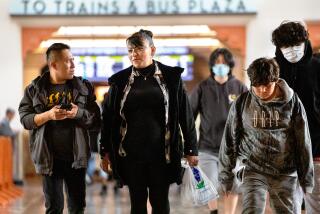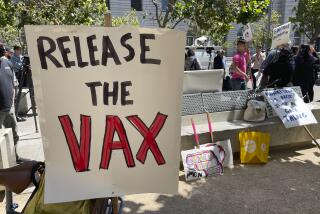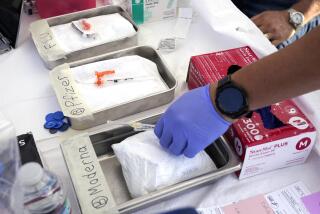More in Hospitals Will Be in Need of Smallpox Vaccine
- Share via
WASHINGTON — Hundreds of thousands of emergency room personnel would probably have to be vaccinated against smallpox to adequately prepare the country for a bioterrorist attack, a senior federal health official said Saturday.
Previous estimates that only 10,000 to 20,000 “first responders” would have to be vaccinated have turned out to be premature and inaccurate, said Dr. Donald A. Henderson, principal scientific advisor to Health and Human Services Secretary Tommy G. Thompson.
For the record:
12:00 a.m. July 11, 2002 For The Record
Los Angeles Times Thursday July 11, 2002 Home Edition Main News Part A Page 2 National Desk 21 inches; 763 words Type of Material: Correction
Smallpox--An article in Section A on Sunday incorrectly reported the origin of the smallpox vaccine. It is made from the vaccinia virus and is not a live form of the smallpox virus.
*
However, Henderson said in an interview there are no current plans to vaccinate all 280 million Americans against the deadly virus, which was eradicated worldwide in 1978 and only exists in laboratory samples.
Thompson is weighing an advisory committee’s recommendations on a strategy for using the smallpox vaccine, which is more dangerous to administer than most common vaccinations. Late last month, a 15-member panel that sets vaccine policy for the nation recommended limiting the vaccine to members of bioterrorism response teams, estimated to number fewer than 20,000.
Requiring that all Americans be inoculated would probably result in the deaths of 300 people because of severe reactions to the vaccine, according to government estimates. Because of that risk, the Advisory Committee on Immunization Practices also recommended against a broad immunization campaign.
“It is the considered judgment of a lot of people that [vaccinating all Americans] is not a good idea, absent a greater threat than is now perceived,” said Henderson. “What we are saying is that we should be prepared, in case that a threat suddenly emerged, we could move.”
However, as the government began analyzing the implications of limited immunizations, Henderson said, it became clear that much larger numbers of medical workers would have to be vaccinated than the initial estimate of fewer than 20,000.
“The numbers involved here are very much larger than many people appreciated,” said Henderson.
That view came into focus as HHS officials began consulting with states and hospitals around the country on how the vaccinations would be carried out. It was quickly evident that personnel in emergency rooms receiving victims of a bioterrorist attack would also have to be immunized.
“We talked at length with medium and large hospitals,” said Henderson. “When you calculate three shifts a day, seven days a week, the doctors, nurses, X-ray technicians, people who draw blood, and attendants start adding up. You might be looking at 200 to 400 people in the course of a week.”
Assuming that 1,000 of the 5,000 hospitals around the country were readied to deal with the consequences of a smallpox attack, some 200,000 to 400,000 medical personnel would have to be vaccinated, Henderson said.
“This would be the first line of health-care workers,” said Henderson.
It’s unclear whether hospitals could require employees to participate. The vaccine is a live form of the smallpox virus, and people taking it must be informed of the risks and sign a statement indicating their consent. People who have just been immunized can also transmit to others the particular form of the virus used in the vaccine.
In the 1960s, when the vaccine was in use, the health profile of Americans was in some ways more resistant than it is today.
“We had very few people with immune deficiency disease,” said Henderson. “And we now have many more people who are undergoing aggressive cancer therapy, or who have had organ transplants, which are also significant risk factors for this vaccine.” The estimates of 300 deaths in a nationwide immunization campaign rely on data from the 1960s.
Nonetheless, the government wants to stockpile enough vaccine for every American in case there is an attack. Currently, there are some 70 million doses available and plans call for producing another 200 million by the end of the year.
The only known samples of the smallpox virus are under the custody of the U.S. and Russian governments. But terrorism experts have worried for years that samples from Russia might fall into the hands of terrorists through the black market.
“We are in a position where, if we needed to, one could undertake a large scale vaccination program in a state or in an area of the country,” said Henderson. “Having said that, we would prefer not to. It is not an innocuous procedure by any means. You could have a lot of deaths.”
More to Read
Sign up for Essential California
The most important California stories and recommendations in your inbox every morning.
You may occasionally receive promotional content from the Los Angeles Times.













